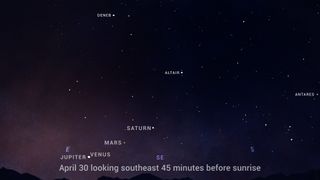Rare Black Moon to block sun in 1st solar eclipse of 2022. See a Venus-Jupiter meetup near Eid, too.
That's a lot of astronomy and celebration packed into a few days.
Update for 6:14 pm ET: TimeandDate.com's webcast for the partial solar eclipse of April 30, 2022 from Chile and Argentina has ended as the sun has set during mid-eclipse. Check out the amazing views from the video above. Read our full wrap story on the solar eclipse.
Black Moon, meet the end of Ramadan.
A rare type of moon will generate a solar eclipse on Saturday (April 30) just ahead of one of the largest festivals in the Muslim calendar: Eid Al-Fitr, the end of the holy month of fasting. Depending on the first sighting of the crescent moon phase, Eid falls on Sunday (May 1) or Monday (May 2) this year.
The April new moon, or the Shawwal Moon to Muslims following the Islamic calendar, will also herald two more celestial events. First, a close approach of Venus and Jupiter just before sunrise on Saturday. Then keep your eyes peeled for the peak of the Eta Aquarid meteor shower on May 4 and 5.
So what's a Black Moon? While not an official astronomical term, Timeanddate.com outlines two situations where the community says this rare new moon happens. (A new moon happens when the moon is fully in shadow from Earth's perspective, and is the only alignment during which solar eclipses can happen, albeit rarely.)
Related: How to watch the April 2022 solar eclipse online
The two types of black moon, the website says, are the second new moon in a single calendar month, or the third new moon in a season of four new moons. April's black moon fits the first definition, although unfortunately, you won't be able to see it.
Get the Space.com Newsletter
Breaking space news, the latest updates on rocket launches, skywatching events and more!
What you can see is the solar eclipse it produces, either in person or online, as the moon briefly passes across a part of the sun from Earth's point of view. The partial solar eclipse of April 30 will sweep across parts of Antarctica, the southern tip of South America and the Pacific and Atlantic Oceans. (If you're lucky enough to be there in person, make sure to wear protective solar eclipse eyewear; never look at the sun without proper protection.)
The eclipse will begin at 2:45 p.m. EDT (1845 GMT), when it will be first be visible to skywatchers in the areas of visibility. The time of maximum eclipse will be at 4:41 p.m. EDT (2041 GMT), with the eclipse ending at 6:37 p.m. EDT (2237 GMT), according to TimeandDate.com. Roughly 64% of the sun's disk will be blotted out at most, according to NASA.
You can prepare for all solar eclipses with our guide on how to photograph a solar eclipse safely. Our best cameras for astrophotography and the best lenses for astrophotography guides will help you pick the best gear to prepare for the next solar eclipse, too.

Don't forget to keep watching the skies for other astronomical events before and after the eclipse.
At sunrise April 30, you'll be able to see Venus and Jupiter on a rare conjunction or close approach, as the planets assemble for an epic five-world lineup visible in June.
Then on May 4 and 5, you can watch leftovers from Comet Halley slamming into the atmosphere to produce the Eta Aquarids. With the moon just a few days past its new phase, the meteor shower should be a pretty good show.
Editor's Note: If you snap an amazing solar eclipse photo and would like to share it with Space.com's readers, send your photo(s), comments, and your name and location to spacephotos@space.com.
Follow Elizabeth Howell on Twitter @howellspace. Follow us on Twitter @Spacedotcom and on Facebook.
Join our Space Forums to keep talking space on the latest missions, night sky and more! And if you have a news tip, correction or comment, let us know at: community@space.com.

Elizabeth Howell (she/her), Ph.D., is a staff writer in the spaceflight channel since 2022 covering diversity, education and gaming as well. She was contributing writer for Space.com for 10 years before joining full-time. Elizabeth's reporting includes multiple exclusives with the White House and Office of the Vice-President of the United States, an exclusive conversation with aspiring space tourist (and NSYNC bassist) Lance Bass, speaking several times with the International Space Station, witnessing five human spaceflight launches on two continents, flying parabolic, working inside a spacesuit, and participating in a simulated Mars mission. Her latest book, "Why Am I Taller?", is co-written with astronaut Dave Williams. Elizabeth holds a Ph.D. and M.Sc. in Space Studies from the University of North Dakota, a Bachelor of Journalism from Canada's Carleton University and a Bachelor of History from Canada's Athabasca University. Elizabeth is also a post-secondary instructor in communications and science at several institutions since 2015; her experience includes developing and teaching an astronomy course at Canada's Algonquin College (with Indigenous content as well) to more than 1,000 students since 2020. Elizabeth first got interested in space after watching the movie Apollo 13 in 1996, and still wants to be an astronaut someday. Mastodon: https://qoto.org/@howellspace